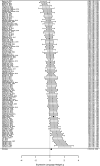Intervention Effects on Language in Children With Autism: A Project AIM Meta-Analysis
- PMID: 32384865
- PMCID: PMC7842122
- DOI: 10.1044/2020_JSLHR-19-00167
Intervention Effects on Language in Children With Autism: A Project AIM Meta-Analysis
Abstract
Purpose This study synthesized effects of interventions on language outcomes of young children (ages 0-8 years) with autism and evaluated the extent to which summary effects varied by intervention, participant, and outcome characteristics. Method A subset of effect sizes gathered for a larger meta-analysis (the Autism Intervention Meta-analysis or Project AIM) examining the effects of interventions for young children with autism, which were specific to language outcomes, was analyzed. Robust variance estimation and metaregression were used to calculate summary and moderated effects while controlling for intercorrelation among outcomes within studies. Results A total of 221 outcomes were gathered from 60 studies. The summary effect of intervention on language outcomes was small but significant. Summary effects were larger for expressive and composite language outcomes compared to receptive language outcomes. Interventions implemented by clinicians, or by clinicians and caregivers together, had summary effects that were significantly larger than interventions implemented by caregivers alone. Participants' pretreatment language age equivalent scores positively and significantly moderated intervention effects, such that effects were significantly larger on average when samples of children had higher pretreatment language levels. Effects were not moderated by cumulative intervention intensity, intervention type, autism symptomatology, chronological age, or the proximity or boundedness of outcomes. Study quality concerns were apparent for a majority of included outcomes. Conclusions We found evidence that intervention can facilitate improvements in language outcomes for young children with autism. Effects were largest for expressive and composite language outcomes, for children with initially higher language abilities, and for interventions implemented by clinicians or by caregivers and clinicians combined. However, quality concerns of included studies and borderline significance of some results temper our conclusions regarding intervention effectiveness and corresponding moderators.
Figures







Similar articles
-
Understanding the Effects of Naturalistic Developmental Behavioral Interventions: A Project AIM Meta-analysis.Autism Res. 2021 Apr;14(4):817-834. doi: 10.1002/aur.2471. Epub 2021 Jan 22. Autism Res. 2021. PMID: 33480474 Free PMC article. Review.
-
Autism intervention meta-analysis of early childhood studies (Project AIM): updated systematic review and secondary analysis.BMJ. 2023 Nov 14;383:e076733. doi: 10.1136/bmj-2023-076733. BMJ. 2023. PMID: 37963634 Free PMC article.
-
Communication interventions for autism spectrum disorder in minimally verbal children.Cochrane Database Syst Rev. 2018 Nov 5;11(11):CD012324. doi: 10.1002/14651858.CD012324.pub2. Cochrane Database Syst Rev. 2018. PMID: 30395694 Free PMC article.
-
Efficacy of very early interventions on neurodevelopmental outcomes for infants and toddlers at increased likelihood of or diagnosed with autism: A systematic review and meta-analysis.Autism Res. 2023 Jun;16(6):1145-1160. doi: 10.1002/aur.2924. Epub 2023 Apr 10. Autism Res. 2023. PMID: 37036800 Free PMC article.
-
Interventions based on early intensive applied behaviour analysis for autistic children: a systematic review and cost-effectiveness analysis.Health Technol Assess. 2020 Jul;24(35):1-306. doi: 10.3310/hta24350. Health Technol Assess. 2020. PMID: 32686642 Free PMC article.
Cited by
-
Receptive language and receptive-expressive discrepancy in minimally verbal autistic children and adolescents.Autism Res. 2024 Feb;17(2):381-394. doi: 10.1002/aur.3079. Epub 2023 Dec 27. Autism Res. 2024. PMID: 38149732 Free PMC article.
-
Characterizing mechanisms of caregiver-mediated naturalistic developmental behavioral interventions for autistic toddlers: A randomized clinical trial.Autism. 2024 Jul;28(7):1847-1860. doi: 10.1177/13623613231213283. Epub 2023 Nov 24. Autism. 2024. PMID: 38006211 Free PMC article. Clinical Trial.
-
Autism and Communication Skills: Perspectives of Special Education Teachers in Saudi Arabia.J Autism Dev Disord. 2024 Oct 24. doi: 10.1007/s10803-024-06611-z. Online ahead of print. J Autism Dev Disord. 2024. PMID: 39446293
-
Quickstart for toddlers with autism spectrum disorder: A preliminary report of an adapted community-based early intervention program.Autism Dev Lang Impair. 2022 Nov 27;7:23969415221138699. doi: 10.1177/23969415221138699. eCollection 2022 Jan-Dec. Autism Dev Lang Impair. 2022. PMID: 36466042 Free PMC article.
-
Variation in morpho-lexical development within and between diagnoses in children with neurodevelopmental disorders.Front Psychol. 2023 Jan 12;13:968408. doi: 10.3389/fpsyg.2022.968408. eCollection 2022. Front Psychol. 2023. PMID: 36710780 Free PMC article.
References
-
- American Psychiatric Association. (2000). Diagnostic and statistical manual of mental disorders (4th ed., text revision).
-
- American Psychiatric Association. (2012). DSM-5 development: Autism spectrum disorder. http://www.dsm5.org/ProposedRevisions/Pages/proposedrevision.aspx?rid=94
-
- American Psychiatric Association. (2013). Diagnostic and statistical manual of mental disorders (5th ed.).
-
- American Speech-Language-Hearing Association. (n.d.). Autism [Practice Portal]. Retrieved August, 12, 2019, fromhttp://www.asha.org/Practice-Portal/Clinical-Topics/Autism/ https://www.asha.org/Practice-Portal/Clinical-Topics/Autism/
-
- Bacon E. C., Osuna S., Courchesne E., & Pierce K. (2019). Naturalistic language sampling to characterize the language abilities of 3-year-olds with autism spectrum disorder. Autism, 23(3), 699–712. https://doi.org/10.1177/1362361318766241 - PMC - PubMed
Publication types
MeSH terms
Grants and funding
LinkOut - more resources
Full Text Sources
Medical

